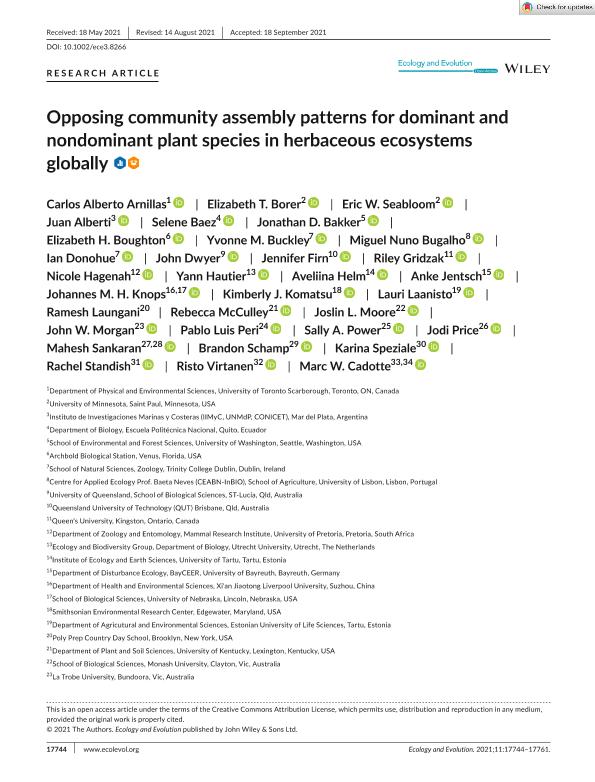Artículo
Opposing community assembly patterns for dominant and jonnondominant plant species in herbaceous ecosystems globally
Arnillas, Carlos Alberto; Borer, Elizabeth; Seabloom, Eric; Alberti, Juan ; Baez, Selene; Bakker, Jonathan; Boughton, Elizabeth H.; Buckley, Yvonne M.; Bugalho, Miguel Nuno; Donohue, Ian; Dwyer, John; Firn, Jennifer; Gridzak, Riley; Hagenah, Nicole; Hautier, Yann; Helm, Aveliina; Jentsch, Anke; Knops, Johannes M. H.; Komatsu, Kimberly J.; Laanisto, Lauri; Laungani, Ramesh; McCulley, Rebecca; Moore, Joslin L.; Morgan, John W.; Peri, Pablo Luis
; Baez, Selene; Bakker, Jonathan; Boughton, Elizabeth H.; Buckley, Yvonne M.; Bugalho, Miguel Nuno; Donohue, Ian; Dwyer, John; Firn, Jennifer; Gridzak, Riley; Hagenah, Nicole; Hautier, Yann; Helm, Aveliina; Jentsch, Anke; Knops, Johannes M. H.; Komatsu, Kimberly J.; Laanisto, Lauri; Laungani, Ramesh; McCulley, Rebecca; Moore, Joslin L.; Morgan, John W.; Peri, Pablo Luis ; Power, Sally A.; Price, Jodi; Sankaran, Mahesh; Schamp, Brandon; Speziale, Karina Lilian
; Power, Sally A.; Price, Jodi; Sankaran, Mahesh; Schamp, Brandon; Speziale, Karina Lilian ; Standish, Rachel; Virtanen, Risto; Cadotte, Marc W.
; Standish, Rachel; Virtanen, Risto; Cadotte, Marc W.
 ; Baez, Selene; Bakker, Jonathan; Boughton, Elizabeth H.; Buckley, Yvonne M.; Bugalho, Miguel Nuno; Donohue, Ian; Dwyer, John; Firn, Jennifer; Gridzak, Riley; Hagenah, Nicole; Hautier, Yann; Helm, Aveliina; Jentsch, Anke; Knops, Johannes M. H.; Komatsu, Kimberly J.; Laanisto, Lauri; Laungani, Ramesh; McCulley, Rebecca; Moore, Joslin L.; Morgan, John W.; Peri, Pablo Luis
; Baez, Selene; Bakker, Jonathan; Boughton, Elizabeth H.; Buckley, Yvonne M.; Bugalho, Miguel Nuno; Donohue, Ian; Dwyer, John; Firn, Jennifer; Gridzak, Riley; Hagenah, Nicole; Hautier, Yann; Helm, Aveliina; Jentsch, Anke; Knops, Johannes M. H.; Komatsu, Kimberly J.; Laanisto, Lauri; Laungani, Ramesh; McCulley, Rebecca; Moore, Joslin L.; Morgan, John W.; Peri, Pablo Luis ; Power, Sally A.; Price, Jodi; Sankaran, Mahesh; Schamp, Brandon; Speziale, Karina Lilian
; Power, Sally A.; Price, Jodi; Sankaran, Mahesh; Schamp, Brandon; Speziale, Karina Lilian ; Standish, Rachel; Virtanen, Risto; Cadotte, Marc W.
; Standish, Rachel; Virtanen, Risto; Cadotte, Marc W.
Fecha de publicación:
12/2021
Editorial:
John Wiley & Sons Inc.
Revista:
Ecology and Evolution
ISSN:
2045-7758
e-ISSN:
2045-7758
Idioma:
Inglés
Tipo de recurso:
Artículo publicado
Clasificación temática:
Resumen
Biotic and abiotic factors interact with dominant plants—the locally most frequent or with the largest coverage—and nondominant plants differently, partially because dominant plants modify the environment where nondominant plants grow. For instance, if dominant plants compete strongly, they will deplete most resources, forcing nondominant plants into a narrower niche space. Conversely, if dominant plants are constrained by the environment, they might not exhaust available resources but instead may ameliorate environmental stressors that usually limit nondominants. Hence, the nature of interactions among nondominant species could be modified by dominant species. Furthermore, these differences could translate into a disparity in the phylogenetic relatedness among dominants compared to the relatedness among nondominants. By estimating phylogenetic dispersion in 78 grasslands across five continents, we found that dominant species were clustered (e.g., co-dominant grasses), suggesting dominant species are likely organized by environmental filtering, and that nondominant species were either randomly assembled or overdispersed. Traits showed similar trends for those sites (<50%) with sufficient trait data. Furthermore, several lineages scattered in the phylogeny had more nondominant species than expected at random, suggesting that traits common in nondominants are phylogenetically conserved and have evolved multiple times. We also explored environmental drivers of the dominant/nondominant disparity. We found different assembly patterns for dominants and nondominants, consistent with asymmetries in assembly mechanisms. Among the different postulated mechanisms, our results suggest two complementary hypotheses seldom explored: (1) Nondominant species include lineages adapted to thrive in the environment generated by dominant species. (2) Even when dominant species reduce resources to nondominant ones, dominant species could have a stronger positive effect on some nondominants by ameliorating environmental stressors affecting them, than by depleting resources and increasing the environmental stress to those nondominants. These results show that the dominant/nondominant asymmetry has ecological and evolutionary consequences fundamental to understand plant communities.
Archivos asociados
Licencia
Identificadores
Colecciones
Articulos(IIMYC)
Articulos de INSTITUTO DE INVESTIGACIONES MARINAS Y COSTERAS
Articulos de INSTITUTO DE INVESTIGACIONES MARINAS Y COSTERAS
Citación
Arnillas, Carlos Alberto; Borer, Elizabeth; Seabloom, Eric; Alberti, Juan; Baez, Selene; et al.; Opposing community assembly patterns for dominant and jonnondominant plant species in herbaceous ecosystems globally; John Wiley & Sons Inc.; Ecology and Evolution; 11; 24; 12-2021; 17744-17761
Compartir
Altmétricas



